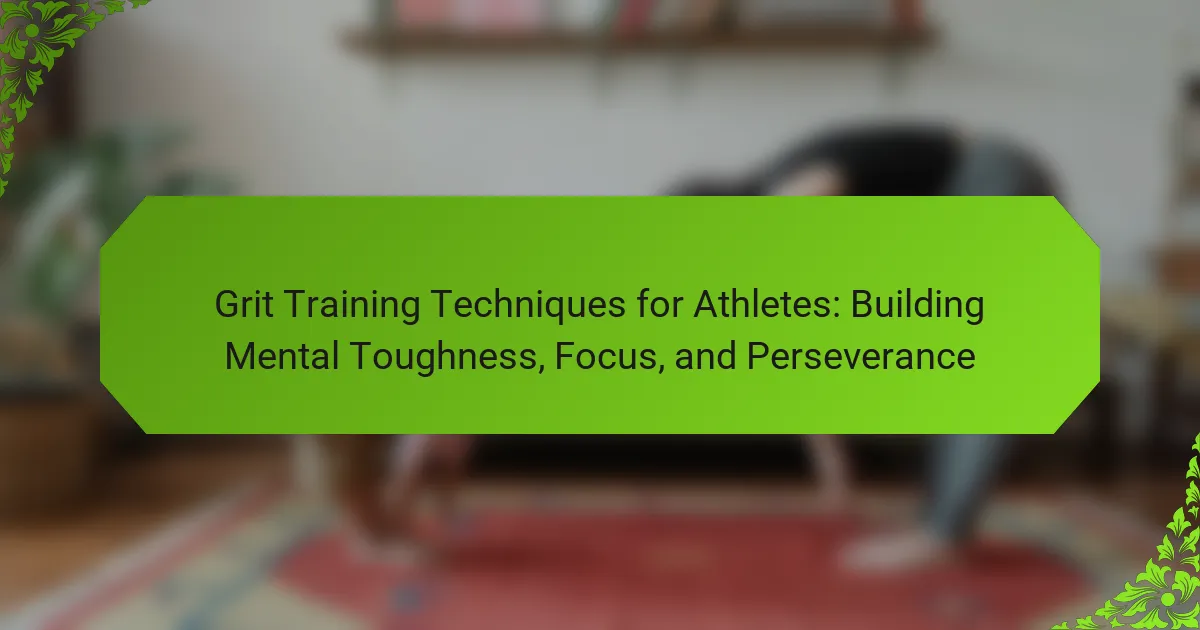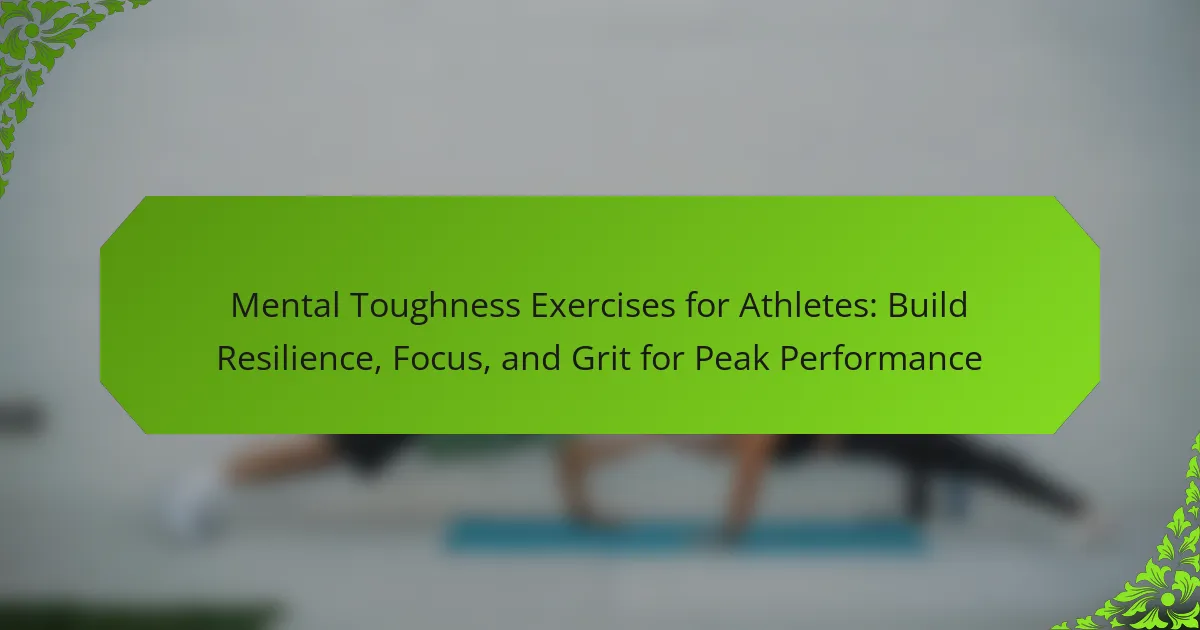Building mental toughness is essential for athletes facing adversity. Grit training techniques focus on setting specific goals, embracing discomfort, and maintaining a growth mindset. Consistent practice and reflection enhance resilience and perseverance. These strategies empower athletes to overcome challenges and improve performance.

What are the foundational principles of grit training for athletes?
Grit training for athletes focuses on developing resilience and perseverance. Key principles include setting challenging goals, maintaining a growth mindset, and embracing discomfort. Athletes must practice consistently, push through setbacks, and cultivate passion for their sport. These techniques enhance mental toughness and enable athletes to overcome adversity effectively.
How does grit contribute to athletic performance?
Grit significantly enhances athletic performance by fostering resilience and determination. Athletes with grit are more likely to persist through challenges, leading to improved training outcomes and competition results. Research shows that mental toughness, a component of grit, correlates with higher achievement levels in sports. Techniques such as goal-setting, visualization, and embracing failure help cultivate grit, enabling athletes to overcome adversity and stay focused on long-term success.
What is the relationship between resilience and grit?
Resilience and grit are closely related concepts that contribute to an athlete’s mental toughness. Resilience helps athletes recover from setbacks, while grit drives them to persist through challenges. Both traits are essential for overcoming adversity in sports. Training techniques that enhance grit, such as setting long-term goals and maintaining a growth mindset, also bolster resilience. Engaging in deliberate practice fosters both attributes, enabling athletes to face obstacles with determination and adaptability.

What are the universal techniques for building mental toughness?
To build mental toughness, athletes can employ grit training techniques that focus on persistence and resilience. Key techniques include setting challenging goals, embracing discomfort, practicing self-discipline, and cultivating a growth mindset. These methods enhance an athlete’s ability to overcome adversity and maintain focus during setbacks. Regularly reflecting on experiences and learning from failures also strengthens mental fortitude.
How can visualization enhance grit in athletes?
Visualization can significantly enhance grit in athletes by improving focus and resilience. It allows athletes to mentally rehearse overcoming challenges, which strengthens their determination. Research shows that mental imagery can lead to better performance and increased motivation. By visualizing success, athletes can develop a unique attribute of mental toughness that helps them persist through adversity. This technique not only fosters confidence but also prepares them for real-life competition scenarios, reinforcing their grit.
What steps are involved in effective visualization practices?
Effective visualization practices involve several key steps that enhance mental toughness in athletes. First, set clear goals to define what you want to achieve through visualization. Next, create a detailed mental image of the desired outcome, focusing on sensory details to make the experience vivid. Incorporate regular practice sessions to reinforce these visualizations, ideally integrating them into training routines. Finally, evaluate progress and adjust imagery as needed to maintain effectiveness.
What role does goal-setting play in developing resilience?
Goal-setting enhances resilience by providing direction and motivation for athletes. It fosters mental toughness, enabling them to tackle challenges. Specific, measurable goals can improve focus and commitment, leading to better performance under pressure. Research indicates that athletes who set clear objectives exhibit higher levels of perseverance and adaptability. This structured approach to training helps athletes navigate adversity effectively, reinforcing their grit and determination.
What are the SMART criteria for setting athletic goals?
The SMART criteria for setting athletic goals are Specific, Measurable, Achievable, Relevant, and Time-bound. These criteria help athletes establish clear objectives that enhance focus and motivation. Specific goals define exact outcomes, measurable goals track progress, achievable goals ensure realism, relevant goals align with broader aspirations, and time-bound goals set deadlines for completion. Implementing SMART criteria fosters mental toughness by promoting commitment and accountability in grit training.
How can athletes use positive self-talk to improve grit?
Athletes can enhance grit through positive self-talk by fostering resilience and motivation. This technique helps them focus on their strengths and maintain a growth mindset. Research shows that positive affirmations can lead to improved performance and lower stress levels. By regularly practicing self-encouragement, athletes build mental toughness, enabling them to overcome challenges and persist in the face of adversity.

What unique strategies can amateur athletes employ to cultivate grit?
Amateur athletes can cultivate grit by setting specific goals, embracing challenges, and maintaining a growth mindset. These strategies enhance mental toughness and help overcome adversity.
1. Set Specific Goals: Create measurable and achievable targets to maintain focus and motivation.
2. Embrace Challenges: View obstacles as opportunities to learn and grow, fostering resilience.
3. Maintain a Growth Mindset: Believe in the ability to improve through effort, which strengthens perseverance.
4. Practice Consistency: Regular training and discipline build endurance and mental fortitude.
5. Reflect on Progress: Regularly assess achievements and setbacks to adapt strategies and reinforce determination.
How does embracing failure contribute to mental toughness?
Embracing failure enhances mental toughness by fostering resilience and adaptability. Athletes learn to view setbacks as opportunities for growth, which builds grit. This perspective allows them to persist through challenges, ultimately improving performance. Research shows that individuals who embrace failure develop a stronger sense of determination, leading to greater success in their athletic pursuits.
What are the benefits of controlled exposure to discomfort?
Controlled exposure to discomfort enhances mental resilience, promoting grit in athletes. This approach encourages adaptation to challenges, fostering a growth mindset. Athletes experience improved stress management, increased focus, and heightened motivation. Research indicates that discomfort training can lead to better performance under pressure. Additionally, it builds confidence by helping athletes confront and overcome fears.
How can athletes implement discomfort training?
Athletes can implement discomfort training by gradually exposing themselves to challenging situations that push their limits. This technique enhances mental toughness and resilience.
1. Set specific discomfort goals, such as increasing workout intensity or duration.
2. Incorporate high-intensity interval training (HIIT) to simulate physical and mental strain.
3. Use visualization techniques to prepare for challenging scenarios, enhancing focus and determination.
4. Engage in cold exposure or heat training to build tolerance to physical discomfort.
5. Reflect on discomfort experiences to identify growth areas and reinforce mental strength.
What is the significance of accountability partners in grit training?
Accountability partners are crucial in grit training as they enhance motivation and commitment. They provide support, feedback, and encouragement, which are essential for developing mental toughness. Studies show that having an accountability partner increases the likelihood of achieving goals by up to 65%. This unique attribute fosters a sense of responsibility, making athletes more likely to push through adversity. The partnership creates a structured environment for tracking progress and maintaining focus.

What rare but impactful practices enhance grit in amateur athletes?
Practices that enhance grit in amateur athletes include visualization, deliberate practice, and adversity exposure. These techniques build resilience and mental toughness.
Visualization helps athletes mentally rehearse challenges, improving focus and confidence. Deliberate practice involves setting specific goals and pushing limits, fostering a growth mindset. Adversity exposure, through facing difficult situations, strengthens coping mechanisms and perseverance.
Incorporating these rare yet impactful practices can significantly enhance an athlete’s grit, leading to better performance and personal growth.
How can journaling foster resilience and grit?
Journaling enhances resilience and grit by promoting self-reflection and emotional processing. Regular writing helps athletes identify challenges and develop strategies to overcome them. This practice builds mental toughness, allowing athletes to navigate adversity effectively. Studies show that expressive writing can improve coping skills and reduce stress, fostering a growth mindset essential for grit development.
What unconventional methods can athletes use to build mental toughness?
Athletes can use unconventional methods like visualization, mindfulness, and cold exposure to build mental toughness. Visualization involves mentally rehearsing challenging scenarios to enhance performance. Mindfulness practices, such as meditation, help athletes stay present and focused under pressure. Cold exposure, like ice baths, builds resilience by pushing physical and mental limits. Each method cultivates grit, enabling athletes to overcome adversity effectively.

How can amateur athletes apply grit training techniques in their daily routines?
Amateur athletes can effectively apply grit training techniques by integrating specific mental challenges into their daily routines. These techniques enhance resilience and focus, essential for overcoming obstacles.
One practical method is setting small, achievable goals that require consistent effort. This fosters a growth mindset, reinforcing the idea that persistence leads to improvement. For instance, athletes can commit to a daily workout, gradually increasing intensity or duration.
Another technique involves embracing discomfort. Athletes should seek out challenging situations, such as pushing through fatigue during training. This builds mental toughness by teaching them to endure and adapt.
Additionally, maintaining a reflective practice helps athletes assess their progress and setbacks. Journaling about experiences fosters self-awareness and encourages a positive outlook, crucial for developing grit.
Incorporating these techniques into daily routines allows amateur athletes to cultivate a strong mental foundation, enhancing their overall performance and ability to face adversity.
What are the best practices for integrating grit training into a training schedule?
Integrating grit training into a training schedule enhances mental toughness. Prioritize consistency, gradually increase intensity, and incorporate varied challenges. Schedule sessions during peak training times for optimal engagement. Include recovery periods to prevent burnout. Regularly assess progress to adapt techniques effectively.
What common mistakes do athletes make when trying to build grit?
Athletes often make several common mistakes when trying to build grit. These include setting unrealistic expectations, neglecting recovery, and failing to embrace discomfort.
Unrealistic expectations can lead to frustration and burnout. Many athletes expect rapid progress, which can diminish motivation. Neglecting recovery is another critical error; rest is essential for mental resilience.
Additionally, avoiding discomfort prevents athletes from developing true grit. Embracing challenges fosters growth and mental toughness. Finally, not seeking feedback can hinder improvement; constructive criticism is vital for grit development.
What expert insights can guide athletes in their grit training journey?
To enhance grit training, athletes can adopt strategies such as setting specific goals, practicing mindfulness, and embracing challenges. These techniques foster resilience and mental toughness. For instance, research shows that athletes who set incremental goals demonstrate improved perseverance. Additionally, mindfulness practices like meditation can enhance focus and reduce anxiety, crucial for overcoming adversity. Engaging in challenging situations, such as high-pressure competitions, builds confidence and grit over time.



